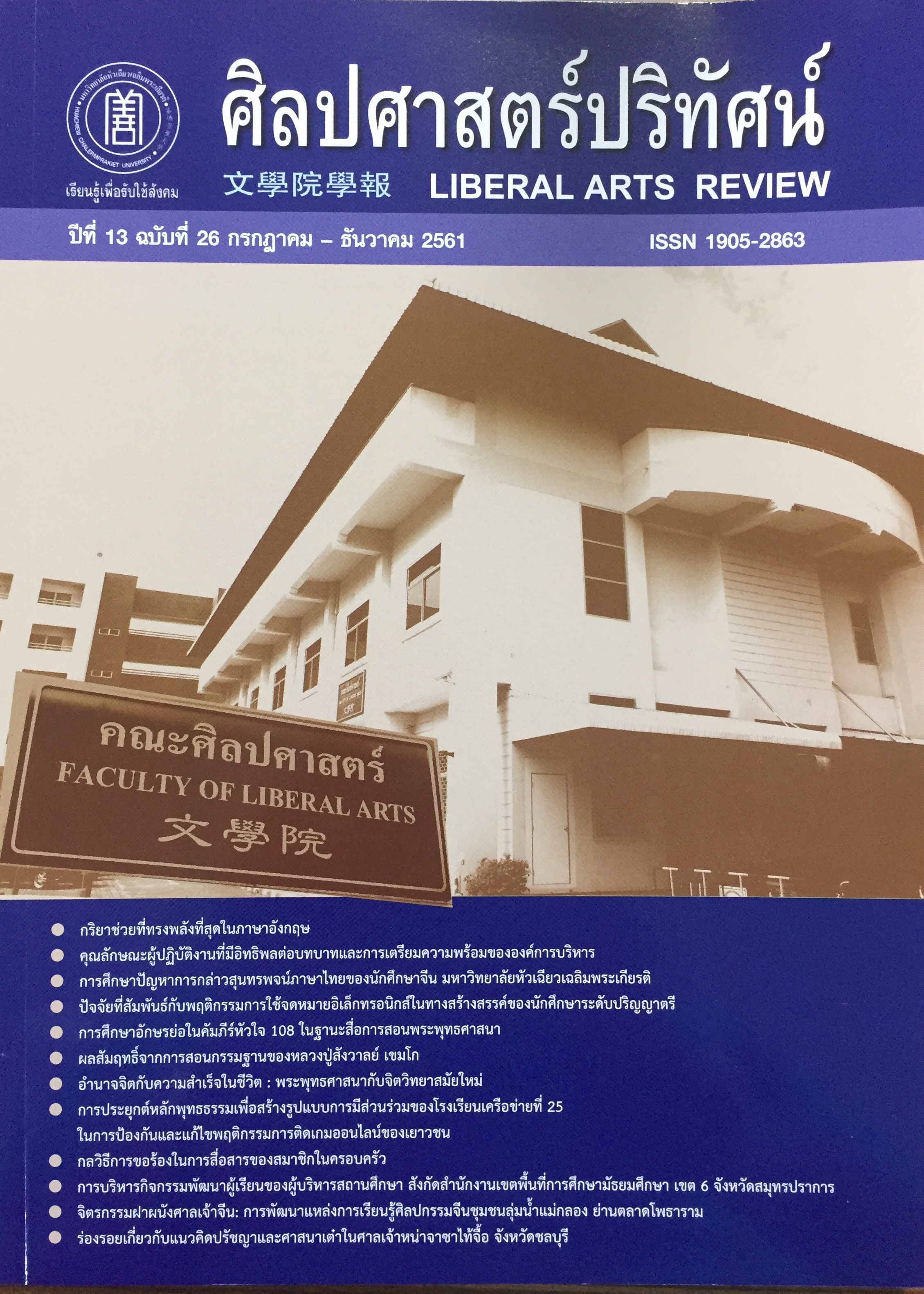Factors related to behavioral use of electronic mail in a creative way by undergraduate students
Keywords:
behavior, attitude, subjective norm, behavioral control, electronic mailAbstract
The objectives of this quantitative research, Factors Related to Behavioral Use
of Electronic Mail in a Creative Way by Undergraduate Students, are to study undergraduate
students’ behaviors concerning creative use of e-mails, the factors related to those
behaviors, and the relationships between the factors and the behaviors. The research’s
sample consists of 400 undergraduate students at Huachiew Chalermprakiet University,
Academic Year 2015. The notable research results, which could be utilized further to
promote behaviors involving creative use of emails, are the followings. Regarding the
data of undergraduate students’ behaviors concerning creative use of e-mails, the
average scores for the aspects of responsibility, morality, and IT evaluation are all in
the statistical criteria of high level. As for the factors of attitude toward e-mail use,
subjective norm, and behavioral control related to the student behaviors concerning
creative use of e-mails, the average scores are all in the statistical criteria of high level.
The factor of attitude toward e-mail use is positively related to behaviors concerning
creative use of e-mails. If someone believes a behavior leads to a positive result, they
tend to have good attitude toward that behavior, and then they, in turn, become willing
to show that behavior, the factor of subjective norm is positively related to behaviors
concerning creative use of e-mails. If someone’s important persons’ behavior is in such
a way, they tend to develop that behavior, the factor of behavioral control is positively
related to behaviors concerning creative use of e-mails. If particular way, they have to
believe that they are capable of controlling that behavior and that it is possible to
complete the behavior.
References
: กรณีศึกษา Facebook. วิทยานิพนธ์ วท.ม. (สาขาการบริหารเทคโนโลยี) กรุงเทพมหานคร :
วิทยาลัยนวัตกรรม มหาวิทยาลัยธรรมศาสตร์.
มหาวิทยาลัยเกษตรศาสตร์. (ม.ป.ป.) ข้อปฏิบัติในการใช้จดหมายอิเล็กทรอนิกส์ (e-mail) มหาวิทยาลัย
เกษตรศาสตร์. [ออนไลน์] แหล่งที่มา : https://www.ku.ac.th/web2012/index.
php?c=adms&m=selcon_th&time=20120906110803 (25 กันยายน 2556)
รัชนีพร ศรีรักษา. (กรกฎาคม-ธันวาคม 2549) “จริยธรรมการใช้เทคโนโลยีสารสนเทศยุคปัจจุบัน”
ศิลปศาสตร์ปริทัศน์. 1 (2) หน้า 75.
ล้วน สายยศ และ อังคณา สายยศ. (2536) เทคนิคการวิจัยทางการศึกษา. พิมพ์ครั้งที่ 3. กรุงเทพมหานคร:
สำนักพิมพ์ศูนย์ส่งเสริมวิชาการ.
วัชถนันท์ ปลื้มใจ, ปกรณ์ ลิ้มโยธิน และ สิริลักษณ์ ทองพูน. (23 มิถุนายน 2559) การรับรู้และทัศนคติ
ที่ประชาชนมีต่อกิจกรรมด้านความรับผิดชอบต่อสังคมของ มหาวิทยาลัยหาดใหญ่. การประชุม
หาดใหญ่วิชาการระดับชาติและนานาชาติ ครั้งที่ 7. สงขลา : มหาวิทยาลัยหาดใหญ่ [ออนไลน์] แหล่ง
ที่มา : https://www.hu.ac.th/conference/conference2016/proceedings/data/4-1pdf (29
กรกฎาคม 2559)
สำนักงานสถิติแห่งชาติ. (2558) “โครงการสำรวจการมีการใช้เทคโนโลยีสารสนเทศและการสื่อสารในครัว
เรือน” [ออนไลน์] แหล่งที่มา : https://service.nso.go.th/nso/nso_center/project/search_
center/23project-th.htm (24 มีนาคม 2558)
เสาวณีย์ ไทยรุ่งโรจน์. (ม.ป.ป.) ผลสำรวจชี้คนไทยรับอีเมล์ขยะมากสุด. [ออนไลน์] แหล่งที่มา : https://
www.thaichamber.org/scripts/detail.asp?nNEWSID=3858 (22 ธันวาคม 2554)
อัยรดา ศิลาโคตร. (2550) ผลกระทบขององค์ประกอบส่วนบุคคล ส่วนประสมทางการตลาด และสังคม
ที่มีต่อความตั้งใจที่จะใช้ระบบโทรศัพท์เคลื่อนที่ที่ใช้อยู่ในปัจจุบัน. ดุษฎีนิพนธ์ ปร.ด. (สาขา
บริหารธุรกิจ). กรุงเทพมหานคร : บัณฑิตวิทยาลัย มาหวิทยาลัรามคำแหง.
ASTVผู้จัดการออนไลน์. (4 สิงหาคม 2558) “นักวิจัยชี้ไทยเป็นต้นตออีเมลลวงชวนโหลด Windows 10
เรียกค่าไถ่ข้อมูล” [ออนไลน์] แหล่งที่มา : https://www2.manager.co.th/Cyberbiz/ViewNews.
aspx?NewsID=9580000087935 ( 8 ธันวาคม 2558)
Ajzen, Icek. (2014) “Attitudinal vs. normative messages: An investigation of the differential
effects of persuasive communications on behavior” [Online] Available : https://www.
researchgate.net/publication/245582784_Behavioral_Interventions_Based_on_the_
Theory_of_Planned_Behavior (8 June 2559)
Hinkle, D. E., William, W. and Stephen, G. J. (1998). Applied Statistics for the Behavior
Sciences. 4th ed. New York : Houghton Mifflin.
Krejcie, Robert V. and Morgan, Daryle W. (1970) “Determining Sampling Size for Research
Activities” Journal of Education and Psychological Measurement. 10 (11) page 308.
Kuo, F. -Y. and Young, M. -L. (2008) “A study of the intention–action gap in knowledge
sharing practices” Journal of the American Society for Information Science &
Technology. 59 (8) page 1224-1237.
The Radicati Group, Inc. (2015) “Email Statistics Report, 2015-2019” [Online] Available :
https://www.radicati.com/wp/wp-content/uploads/2015/02/Email-Statistics-Report-
2015-2019-Executive-Summary.pdf (12 February 2016)
Ryu, S., Ho, S. H., and Han, I. (2003) “Knowledge sharing behavior of physicians in hospitals”
Expert Systems with Applications. 25 (1) page 113-122.
Downloads
Published
How to Cite
Issue
Section
License
บทความที่ได้รับการตีพิมพ์เป็นลิขสิทธิ์ของวารสารศิลปศาสตร์วิชาการและวิจัย
ข้อความที่ปรากฏในบทความแต่ละเรื่องในวารสารวิชาการเล่มนี้เป็นความคิดเห็นส่วนตัวของผู้เขียนแต่ละท่านไม่เกี่ยวข้องกับมหาวิทยาลัยหัวเฉียวเฉลิมพระเกียรติ และคณาจารย์ท่านอื่นๆ ในมหาวิทยาลัยฯ แต่อย่างใด ความรับผิดชอบองค์ประกอบทั้งหมดของบทความแต่ละเรื่องเป็นของผู้เขียนแต่ละท่าน หากมีความผิดพลาดใดๆ ผู้เขียนแต่ละท่านจะรับผิดชอบบทความของตนเองแต่ผู้เดียว




